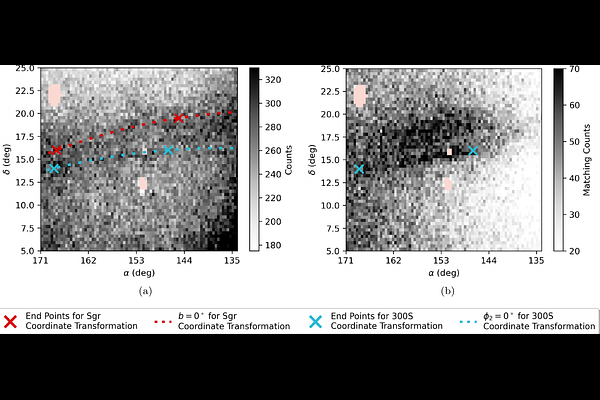Sifting for a Stream: The Morphology of the $300S$ Stellar Stream

Sifting for a Stream: The Morphology of the $300S$ Stellar Stream
Benjamin Cohen, Alexander P. Ji, Peter S. Ferguson, Sergey E. Koposov, Alex Drlica-Wagner, Andrew P. Li, Ting S. Li, Lara R. Cullinane, Gary S. Da Costa, Denis Erkal, Kyler Kuehn, Geraint F. Lewis, Sarah L. Martell, Andrew B. Pace, Daniel B. Zucker, Petra Awad, Joss Bland-Hawthorn, Guilherme Limberg, Clara E. Martínez-Vázquez, Joshua D. Simon, Yong Yang
AbstractStellar streams are sensitive laboratories for understanding the small-scale structure in our Galaxy's gravitational field. Here, we analyze the morphology of the $300S$ stellar stream, which has an eccentric, retrograde orbit and thus could be an especially powerful probe of both baryonic and dark substructures within the Milky Way. Due to extensive background contamination from the Sagittarius stream (Sgr), we perform an analysis combining Dark Energy Camera Legacy Survey photometry, $\textit{Gaia}$ DR3 proper motions, and spectroscopy from the Southern Stellar Stream Spectroscopic Survey ($\textit{S}^5$). We redetermine the stream coordinate system and distance gradient, then apply two approaches to describe $300S$'s morphology. In the first, we analyze stars from $\textit{Gaia}$ using proper motions to remove Sgr. In the second, we generate a simultaneous model of $300S$ and Sgr based purely on photometric information. Both approaches agree within their respective domains and describe the stream over a region spanning $33^\circ$. Overall, $300S$ has three well-defined density peaks and smooth variations in stream width. Furthermore, $300S$ has a possible gap of $\sim 4.7^\circ$ and a kink. Dynamical modeling of the kink implies that $300S$ was dramatically influenced by the Large Magellanic Cloud. This is the first model of $300S$'s morphology across its entire known footprint, opening the door for deeper analysis to constrain the structures of the Milky Way.